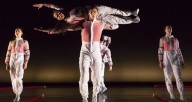You don’t have to hear a definition of “chaos” to feel the extreme state of tension in Hedwig Dance’s premiere virtual performance, “KAOS,” but the calm female voice enunciating the letters, “C-H-A-O-S” adds to its jarring impact.
Hedwig Dances describes its first-ever piece designed expressly for virtual performance as motivated by “the human need to generate order out of chaos.” Partially inspired by Stanley Moss’s poem, “Chaos,” Hedwig Dance’s “KAOS” is filmmaker/choreographer Rigoberto Saura’s response to the world-altering events of the past six months. The piece marks a bold step for the dance company into the existential challenges of continuing to create new work and to perform during these pandemic times.
“KAOS” begins with a sideways view of a woman’s eye filling the screen, then her nose and gradually her lips. They are sensuous and compellingly askew. We see every detail, sometimes multiplied in translucent images overlapping each other, and then coming back into singular focus, as if the abstractions of cubism or Picasso’s displacement of body parts could be choreographed into motion.
A woman’s voice intones the definition of chaos: “messy, out of control.” The face becomes troubled; eyes reflect fear. The voice continues, “a state of extreme disorder and confusion.” Eyebrows pinch together, questioning, confused. The face becomes its own stage, and a choreographic palette of facial features in minute detail dances on it with a quality we could never experience from a seat in the theater.
Composer Henry Labrada’s electronic score pulses to agitated fingers clenching and opening. They scroll across the face, covering eyes, tracing the contours of the nose. Percussive accents propel fingers as they crawl over the slope of a shoulder, across the bare landscape of a smooth upper back. Emotion intensifies as the eyes of the camera magnify every detail.
Labrada’s sound score seemingly bleeds out from the pores in the woman’s skin as variations in the intensity and acceleration of hand and finger motion across the woman’s face build tension almost to the breaking point, then culminate in silence.
A scene shift focuses on a man’s back. We see an arm, a shoulder, a neck or jaw, a hand. This time, the hand recedes as fingers retreat across the slope of a bare shoulder into oblivion and the film segment ends in silence.
Here, I first noticed Saura's deft technical manipulation of film to alter speed, repetition and sequence in ways that cannot be replicated live on stage. His selective editing felt like the hand of a painter of time, space and energy, truly forging a new artistic platform for choreographic expression.
The transition to virtual live streaming is seamless, with voice-over excerpts from Moss’s poem: “There are places for chaos on the page…” as we segue to Sauro, also a dancer in the piece, backing up into the corner of an entirely white room. “I trust in disorder,” the poem continues, transitioning to a new path of discovery and a quest for a way to go on, this time perhaps in the light of chaos, rather than its darkness. A symphonic melody wafts a distant musical backdrop, as if an echo from a more ordered past.
Jacob Buerger, in his virtual space, responds to voice-over commands: “Hands together…Closer. Hands over the face.” It becomes the choreographic score for the gesture dance we first encountered on film in the chaos of fear and confusion, now executed in the order and calmness of understanding. “The enemy is symmetry,” the poem continues. Two women, Olivia Gonzalez and Jessie Gutierrez, each appear in individual settings navigating a home environment, one diving repeatedly onto a bed, the other over a sofa.
Pulsating music drives the images to increased agitation as the four dancers converge in four rectangles on the screen, all doing the same moves but in different sequences.
In the end, all four faces cut and splice in a screen dance that recaps, in accelerating speed, the first facial gestures that open the piece, to a final, quizzical last word—which was a bit hard to discern—but I heard “deisel.”
These four dancers are beautiful to watch in the simplicity and clarity of their presence. Full body movements become incidental events interspersed with movement that focuses on the face, hands and upper body, aspects of performance we often miss in live theater performance. The effect is riveting and its message deeply felt. “KAOS's” blend of film and virtual performance redirects our attention from conditioned expectations to the surprisingly rich expressive possibilities inherent in the form.
One of the great cries coming forth from the dance world during the pandemic has been the inadequacy of virtual performance or film to approximate the values of live performance as experienced in a theater. Saura’s “KAOS” does not approximate. It is its own, very different animal, and in its creation, we are witness to a bold, creative resilience, rebounding from the chaos of our time to rally in the spirit of Moss’s magnificent poem: “I trust glorious chaos. I smell in disorder/ the outhouse of order…” In “KAOS,” Saura and Hedwig Dances promise a healthy forum for a new phase of creativity. May they flourish!


